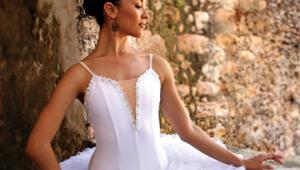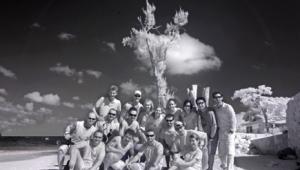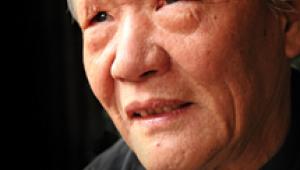Master Class
Shutterbug's Alaskan Cruise
All Photos © 2004, Monte Zucker, All Rights Reserved
Put together a boatload of Shutterbug fans looking for a fun, educational experience
and you can bet that they're going to have the time of their lives! We
did! Every day a new port. Every day more picture opportunities. Every day a
chance to stand beside and shoot with instructors Don Gayle, Bryan Linden, and
George Schaub.
The group divided up with the different instructors each day. In the evenings
the instructors had dinner with a different group of photographers. It was an
incredible experience for us all! Lifetime memories and friends were made that
week. It would be impossible to describe all the adventures we had during our
cruise, but some of my snaps might give you a small idea of the fun that we
had.
Although an overwhelming majority of those in attendance were already well ensconced
in the digital era, there were still a few holdouts saying that they would never
give up film. Needless to say, after listening to all the instructors as well
as to the other photographers in attendance, by the end of the cruise they had
all pretty much made up their minds to move on happily to the new era of image
making. The advantages of digital were just too much for them to ignore any
longer.
My camera for the trip was a Canon EOS 10D. The lenses I used primarily were
the 28-135mm IS and 17-35mm. On occasion I used 14mm and 400mm lenses. My memory
card was Delkin's new 1GB card. My tripod was the extremely lightweight
and durable Manfrotto Carbon One 443 with a Manfrotto 488 head.
I carried all my gear in a fantastic Lowepro Pro Mag 2 AW camera bag that was
lightweight and which held all my camera bodies and lenses. The shoulder strap
on it was extremely comfortable and shaped to keep the bag from slipping. It
was quite a lifesaver, especially with all the hiking that we did that week
and some of the bad weather through which we trekked. The camera bag even has
its own all-weather cover. What a blessing that was in Alaska! Tamron provided
a complete supply of lenses for people to use during the cruise.
I had only recently become addicted to using an ExpoDisc (www.expodisc.com)
for white balancing and had that hanging around my neck for the entire trip.
All you have to do for exceptional white balancing is first get the right exposure,
then pop the disc over your lens for another picture as you point the camera
toward the scene that you're photographing. Then, tell the camera that
this is the image you want to use for custom white balancing. As long as you're
working in that same lighting condition the results are remarkable. When you
change lighting conditions it takes only seconds to do another custom white
balance. What a difference it makes when you're back at your computer
checking out your results!

One of our first shore expeditions from the ship led us to a bend of this
foggy creek at the base of some incredible mountains. Before we even began to
shoot I saw the possibility of a group picture made here. In just a matter of
seconds everyone got together for this picture, getting the day off to a fun
start.
The fog was rolling in, setting up a scenario for pictures that could not have
been better had the sun been shining down upon us. Of course, we had been told
to expect cloudy, cold, damp, rainy weather all week, so this was no big surprise.
The surprise came later in the week when I learned from one of the other instructors
about a new part of Photoshop CS that allowed me to pick up detail in photographs
that wasn't apparent when I first looked at many of my images.
 Leave
it to me to create a portrait situation wherever I am. While we were at this
location a fabulous face walked by, and I just had to stop him and invite him
to be our model for a few minutes. Turned out that Bob was a tour guide. He
looked like he just blended in completely with the surroundings--a truly
local character. He was pretty tall and I wasn't carrying a posing stool
with me. I couldn't get high enough to do his portrait, so I had him stand
on a downhill slope to lower him for this shot.
Leave
it to me to create a portrait situation wherever I am. While we were at this
location a fabulous face walked by, and I just had to stop him and invite him
to be our model for a few minutes. Turned out that Bob was a tour guide. He
looked like he just blended in completely with the surroundings--a truly
local character. He was pretty tall and I wasn't carrying a posing stool
with me. I couldn't get high enough to do his portrait, so I had him stand
on a downhill slope to lower him for this shot.
I knew that I was going for the 2/3 camera position for his portrait, but I
didn't know how well he would cooperate. I began with a quick full-length
portrait. As he relaxed more and more in front of my camera I moved in closer
and closer, until I ended up with this one. He loved it, needless to say, and
posed for more of our photographers that same day when they also came across
him.
A quick turn to the left and there was this incredible bridge coming out of
the fog. I quickly framed this shot, although I knew that there was really no
single focal point in the picture to hold the viewer's attention. That
didn't bother me, because I knew that I had filed a silhouette in my computer
of some men in a canoe that I had made in Ely, Minnesota, several summers ago.
I figured that I would be able to use it again in another picture.
Before I snapped the shutter I had this finished picture in mind.
At home I moved the canoe onto the bridge picture. I sized it in Photoshop's
Free Transform to match where I placed it in the picture. I felt that it was
a little too sharp to go with the rest of the picture, so I put some fog over
it, picking it up with the Rubber Stamp tool from right next to where I had
placed it. The final touch was to blur it a little to make it blend even more.
In addition to the image of people in a canoe, I keep a flying bird and lots
of cloud pictures on file. You just never know when you need a little extra
"something" to complete a composition.

 As
we were hiking all through the Alaskan countryside I kept telling my groups
to look for backlighting: Look on the shady side of the paths, not the sunny
side as that's where all the pictures are hiding. With those comments
I looked up and saw these backlit trees arched over our heads.
As
we were hiking all through the Alaskan countryside I kept telling my groups
to look for backlighting: Look on the shady side of the paths, not the sunny
side as that's where all the pictures are hiding. With those comments
I looked up and saw these backlit trees arched over our heads.
I used my wide angle 14mm Canon lens on my Canon EOS D60 that was converted
to infrared imaging thanks to www.irdigital.net (e-mail: irguy@irdigital.net).
Most Canon digital cameras and the Nikon D100 can be converted, but then they
record only infrared. The conversion creates infrared results automatically
with each shot. The images I got with this camera were breathtaking! Sunlight
on trees does wondrous things in infrared.
But the best part of what I did here was to get the photographers who were accompanying
me to look in places where they hadn't ever looked before. There were
countless images hiding everywhere. Many of the photographers found them with
the help of all the instructors.
Rain just wasn't a problem for many of us. We had prepared for it and
were ready to shoot come what may. What some of the photographers hadn't
realized, however, was how intense the depth of color can be when you're
shooting in misty weather. I did a few under cover individual portraits and
then brought the group out into the open where there was a carved bird in the
center of town. Instead of posing the group directly under the carving I kept
them far in front of it and used the bird as a background, so that they could
remember where they were when this picture was made.
This was such a quick grab shot that the telephone pole was at a terrible slant
in the picture. I straightened it much the same way I straighten a horizon line.
That is, in Photoshop I go under the Eye Dropper tool to the Measure tool. You
can click on one place in a picture and then (while holding down the mouse)
drag the tool to the other end of the line. You can do this both vertically
and horizontally. The finish of this is to go to Image/Rotate Canvas/Arbitrary.
It shows you how far off you are in degrees. To straighten the line all you
have to do is click on "okay." Wow!

I was amazed at how many of the scenic photographers on the trip became interested
in people pictures after I had given my program on the first day of the cruise.
The interest in people pictures grew as the cruise continued, too. Although
most of the photographers were a little intimidated at the thought of photographing
people, they were more than willing to pose for my camera. They studied intensely
what I was doing and checked out the results with great anticipation. Pretty
much all of them had no idea about how much fun they could have by doing a facial
analysis and photographing people in controlled lighting sources outdoors. Before
long everyone seemed to be studying faces and deciding how they would photograph
each of them. It was truly amazing and gratifying.
















































